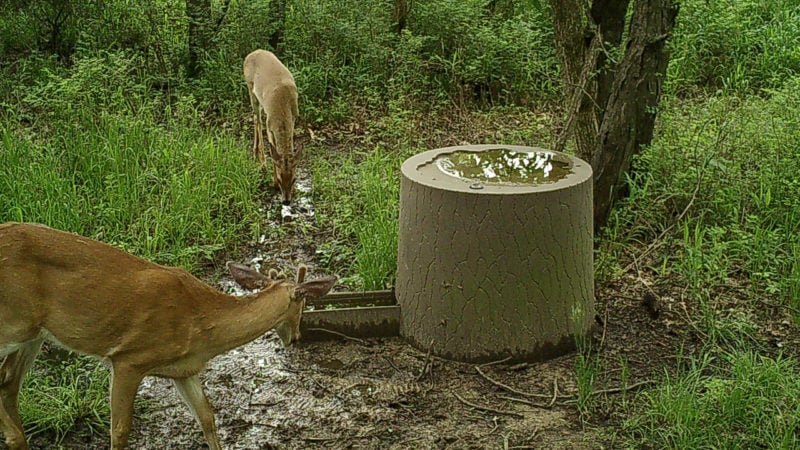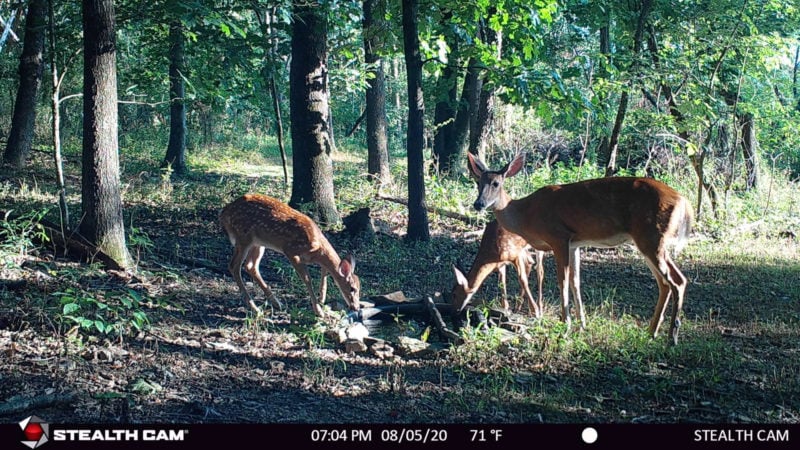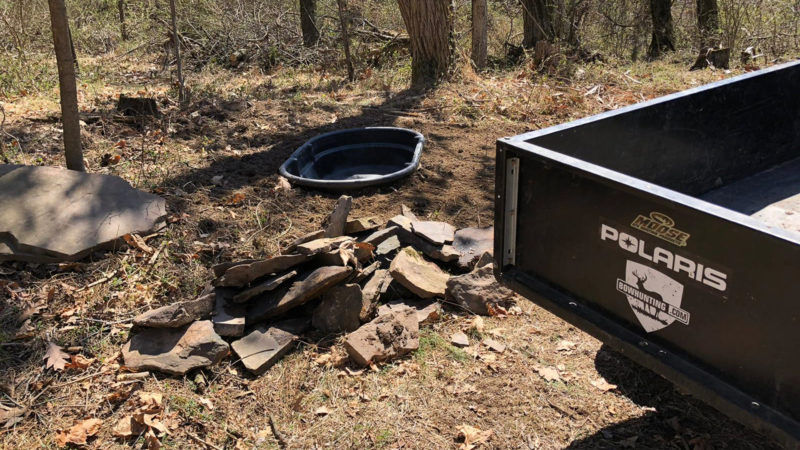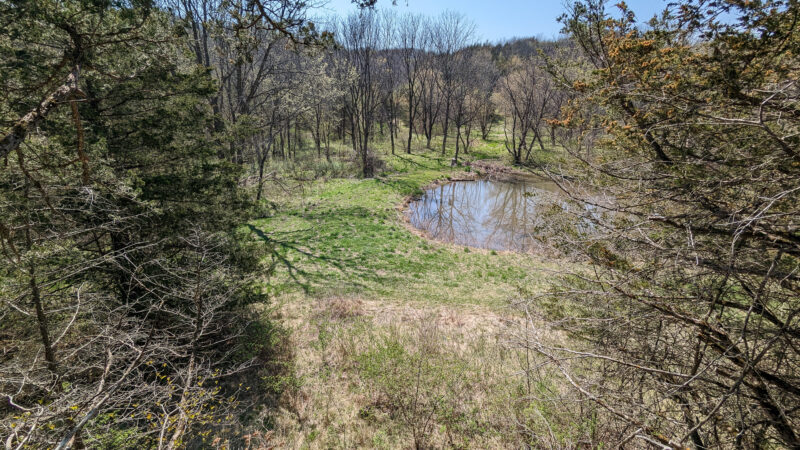Baiting deer has been a controversial topic for decades. Whether it’s legal or not where you hunt, feed baiting has a stigma that is hard to shake. Despite some of these opinions, baiting is a tradition and ‘way of life’ in many areas like Texas and tradition-rich whitetail states like Michigan.
In today’s age of purist whitetail hunting and debates over crossbows and everything else you can think of, throwing down a pile of corn has caused a lot of division amongst hardcore archery, crossbow, and firearm hunters. As an alternative to baiting, man-made waterholes have risen in popularity over the last few years and are catching the attention of researchers.

As part of land ownership and with the popularity of leasing land for the sole purpose in the pursuit of mature deer, heavy emphasis has been placed on land management, food plots, and hunting improvements over the last 10 years or so. Whether you like it or not, whitetail hunting is big business in 2023 and the train isn’t slowing down.
You will be hard-pressed to find a better whitetail hunting improvement than installing a waterhole by way of a rubber tub, or by digging out a larger waterhole with heavy equipment. The question is ripe for asking, but I’ve rarely seen it talked about or answered. Why wouldn’t man-made waterholes be illegal in states or counties where feed baiting is banned due to concerns over Chronic Wasting Disease? I asked a few top experts.
Why Aren’t Waterholes Illegal In Infected Counties?
If you’ve ever dug in a small water tub at a well-traveled rut area, you understand their drawing power. If you think rationally and compare a pile of corn vs. a waterhole, logic would tell you a small waterhole would be just as bad (or worse) than a pile of corn in terms of the spread of Chronic Wasting Disease. It is a fact that deer are able to spread CWD from one deer to another through saliva. Let’s put it this way—I can’t imagine that a tiny, stagnant waterhole is any safer than a pile of corn.
In case you’re not paying attention, heavy whitetail states are pretty concerned about the spread of Chronic Wasting Disease. Chronic Wasting Disease is spread not only from contact between deer, but recent research has shown prions to be present in the soil at scrapes.

It’s understood that infectious prions can very likely be spread by deer eating the same vegetation in a food plot, eating off the same bait pile, and most likely via saliva at small stagnant water sources like rubber or man-made waterholes. To date, no agencies are aware of a waterhole ever being tested for infectious CWD prions. Bryan Richards is the Emerging Disease Coordinator for the USGS and told me “I am not aware that anyone has or is explicitly looking at water holes to determine prion burden. They likely would not be much different than some of the mineral licks that Mike Samuel’s group monitored and were able to detect a prion burden.”
I asked a few large agencies why they believe man-made waterholes aren’t illegal in counties where feed baiting is banned. Jason Sumners, Deputy Director of Resource Management for the Missouri Department on Conservation told me “When you introduce issues like this it can lead to confusion, and at times, very ambiguous regulations that are difficult to define, interpret, and then enforce. When does it go from just a small wildlife watering hole to a pond?”
Sumners brings up a good point. Larger water sources that reach the point of a pond are a valuable addition to someone’s land, create aesthetics, can be fished, and certainly benefit all kinds of wildlife. Drawing a lawful line that makes sense could prove difficult.
Jasmine Batten is a Health Specialist with the Wisconsin Department of Natural Resources. She said in an email “While eliminating man-made water structures alone is unlikely to curb the spread of CWD, reducing as many known risks simultaneously strengthens the likelihood that we can successfully reduce overall CWD transmission and spread.”
Although waterholes are legal in every county throughout Wisconsin, the state strongly discourages any small, non-free flowing water source that congregates deer. A Wisconsin CWD recommendations document even goes so far to say “organic matter in water troughs allows for increased prion accumulation and the potential for prolonged infectivity compared to clean water sources.” Currently, feed baiting is only legal in 17 of Wisconsin’s 72 counties.

Why would waterholes be legal where feed baiting is banned? Before it looks like I’m pointing a finger too harshly, let me explain a few agreements I came to with department experts. In email communication with Deer Program Specialist in Wisconsin, Jeff Pritzl, we agreed the existing historical stigma around feed baiting is so strong that feed baiting is the first thing to go when CWD is discovered in a new county. Pritzl said, “Artificial water sources really hadn’t become a thing yet; at least not the trendy thing to do that we see now.”
Wisconsin has an interesting process for potential rule changes regarding the definitions of baiting. The Wisconsin DNR is allowed to change the language and definition of what feeding or baiting consists of through the Administrative Rules, which could theoretically expand the definition for feeding and baiting to include man-made water holes.
Jasmine Batten said “State statute does direct the DNR to promulgate rules related to feeding deer, but the actual definition of ‘bait” comes through our administrative rules process. So, that means the DNR could actually bring forward a rule change to include man-made water holes as bait or feed. It would still be subject to state rule making processes.”
Batten told me the idea of adding small water sources to the definition of bait or feed was considered in recent years, but it didn’t have enough support to move through the rule amendment process.
Would Banning Water Holes Help Slow CWD?
Deer groom one another, hang out in bachelor groups, and socialize every day of the year, so there is legitimacy in asking the question of whether or not banning small waterholes would even help curb the spread of Chronic Wasting Disease.
In early June, experts gathered at the International CWD symposium in Denver. Questions arose about what sort of dose of infection prions is sufficient enough to create a CWD infection. Jason Sumners said, “New techniques are being developed that are much more sensitive and they are now able to detect CWD in a variety of places. In terms of waterholes and CWD, it raises the question of, is there enough to be meaningful in causing an infection?”
Sumners and I both agreed there is a strong likelihood of small kiddie-pool water sources containing CWD prions in high prevalence rate areas. Also, it depends how long these small water sources are out on the landscape. As Sumners alluded to, experts are working on a more rapid test approach capable of detecting small amounts of prions, but we aren’t there yet.

Erik Hildebrand is a Wildlife Health Supervisor in Minnesota and told me “Here in Minnesota DNR, we utilize a post mortem, USDA-validated test for CWD testing in deer and other cervids (ELISA and IHC). There is no validated test currently to test surfaces or other environmental tests. However, we have collaborated with university researchers that are using research based, non-validated diagnostic tests on surfaces such as stainless steel and glass to see if they can detect prion presence.”
Laws aren’t likely to significantly curb the spread of CWD. If there is anything I’ve learned regarding CWD, it’s that one single action will not add up to large change, it will take an accumulation of efforts by hunters. Banning waterholes will in theory help, but it’s impossible to stop deer from socializing and coming into contact with one another. Outlawing waterholes will not only anger hunters, but it may not significantly help stop the spread.
Batten was frank in telling me “It is increasingly clear to me that legislation alone isn’t enough to move the needle on Chronic Wasting Disease. At the end of the day it’s really about people and whether or not we are willing to collectively re-think our relationship with deer and deer management.”
Want to build a waterhole of your own? Check out How To Build a Waterhole for Deer.

 By
By 



